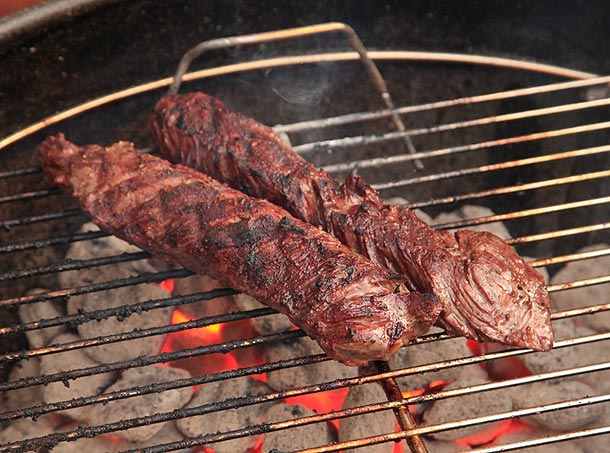
[Photographs: J. Kenji Lopez-Alt]
Hanger is like that indie band that hasn’t quite hit top-40 mainstream status yet, but is big enough that everybody and their mother’s heard about it. Most have even given it a try. For a long, long time it wasn’t even sold to the general public, reserved mostly for ground beef, or taken home by the butchers (earning it the nickname “butcher’s steak.” If you lived in France, you would have seen it on bistro menus as onglet—a popular cut for steak frites. In the U.S., however, your chances of running into it were much slimmer.
Then, some time around the late 1990s, early aughts, chefs caught wind of it and it started appearing on menus of American bistros and fancy restaurants alike. They liked it because it offered the full, beefy flavor and richness of more expensive cuts of meat like ribeye or strip, without the hefty price tag.
These days, it’s become so popular that it’s no longer as dirt cheap as it used to be (after all, there are only two on each steer, and they aren’t particularly large), but it still comes in at around half to a third the price of a typical high-end steak at the supermarket.
HOW TO BUY IT
Alternative Names: Butcher’s steak, hangar (this is an incorrect spelling but appears frequently), arrachera (Mexico), fajitas arracheras (South Texas), bistro steak, onglet (France).
Where it’s Cut From: From the plate section of the cow (the front of the belly), it “hangs” off of the cow’s diaphragm, hence the name. U.S. meat-cutting classification of NAMP 140.

Hanger steaks come in a few different forms in the market. Straight from the steer, it comes as two rather large, loose-grained muscles stuck together side to side with a tone of connective tissue and silverskin surrounding it. If you’re lucky, you’ll have a good butcher who knows how to break this down into two separate, well-trimmed steaks. Each one will be about a food long and weigh in at 8 to 12 ounces, with a triangular cross section.
I’ve seen these individual steaks butterflied into wider, thinner steaks supposedly to make for more even cooking. Really, a butterflied hanger steak is too thin to cook to medium rare while still developing a nice crust, so I’d avoid buying them. Instead, stick to a regular trimmed steak, or buy it untrimmed and do it yourself.
HOW TO TRIM IT
You’ll want to first start by removing all silverskin and excess fat from the exterior with a sharp, sharp boning knife.

slide the tip of the knife under the silverskin, grab the skin with your free hand, then carefully pull the kife under it, taking off as little meat as you can. Eventually, you’ll end up with a piece of meat with two muscles attached by a thick sinew that runs down their center, like this:

Cut the steak in half along that sinew to separate it into two individual hanger steaks, then trim each one down, and you’re ready to cook.

HOW TO COOK IT
There are a number of ways to cook hanger both indoors and out, but no matter where you cook it, you want to make sure that you cook it to medium-rare or medium, no more, no less. Unlike, say, a ribeye steak, which will still be pretty tender and juicy at medium or beyond, a hanger steak has a very coarse texture with a distinct grain running through it. Anywhere beyond medium, and it gets too rubbery to chew.
Undercook it, on the other hand, and you get meat that is mushy and slippery. Rare hanger steak is simply not the same as rare tenderloin, ribeye, or strip. Use a thermometer, and cook it to the sweet spot between 125° and 130° degrees (this gives it some leeway to rise in temperature was it rests).

Very high heat is essential as well. Hanger steaks are relatively thin, and you want to give them a nice char before they get a chance to start overcooking. When going on the grill, I’ll pile up a full chimney of coals under one side of the grill grate and cook them full blast from start to finish, flipping occasionally until they’re done.
In a pan, use cast iron and go for smoking hot high heat.
Finally, hanger steaks are good candidates for sous-vide cooking, as it guarantees that they cook evenly all the way through. Cook them in a 125° to 130°F water bath, then finish them off with the highest possible heat on a grill or stovetop.
When serving, it is essential to slice the meat against the grain. This will shorten the long, grainy muscled fibers, making it easier to chew. When properly cooked and sliced, a hanger steak is every bit as tender as a ribeye.
OTHER FLAVORINGS AND SAUCES
Because of its loose texture, hanger takes well to marinating. I generally rub mine in a mixture of olive oil with garlic, fresh herbs, and peppercorns for a day or so before wiping it dry and grilling with plenty of salt and pepper. The oil helps the seasonings spread their flavor earound the meat, as well as aiding in browning on the grill.

It’s one of the best cuts for various South American, Mexican, and Southeast Asian recipes as well, as it takes well to citrusy marinades or dressings, as well as spicy sauces.












